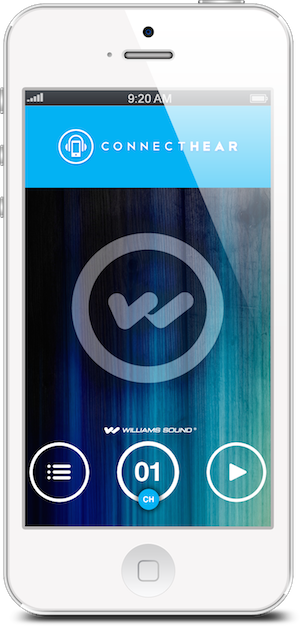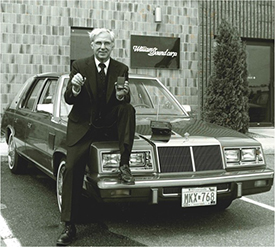Williams Sound founder Jerry Williams grew up building radio kits and repairing neighbors’ small electronics. Then after serving in the Navy in WWII, he returned home to attend St. Olaf College in Minnesota, where he worked at WCAL, which led to his pursuit of an Electrical Engineering degree at the University of Minnesota. Williams launched his career at Zenith and then moved on to Univac and Control Data among other well-known electronic outfits.
Williams Sound founder Jerry Williams.
But it was while Williams was working at Control Data that inspiration struck. Always being the go-to electronics guy in every community, Williams was of course responsible for the sound system installation at his church and others in the community. He’d provided headphones and jacks for the hard-of-hearing in pews in some instances, but noticed that a stigma soon became attached to these “deaf rows”.
Having seen this as the case, Williams had been ruminating for sometime about a new wireless hearing assistance solution based on transistor technology that was quite new at the time. The chance to use this new system, which paired a regular transistor radio with a transmitter built by Williams, arose when a fellow member of his congregation reported that even with her hearing aid, which was sufficient in most scenarios, she was unable to hear church services. The success of this initial experiment led to Williams launching a business in 1976, providing hearing assistance devices to churches across the Midwest.
Since those early years, Williams Sound has expanded its range of products to cover larger and larger applications. But all the while, says Paul Ingebrigtsen, president and CEO of Williams Sound, “We’ve always kept in mind the needs of the individual.”
Williams, who retired in 1987, definitely set the company on a course of technical innovation that benefits individuals across a wide spectrum of applications. Over the past four decades, a series of Williams Sound innovations have arrived in tandem with technological change, and that progress continues today.
Following the AM and FM radio transmission products that initiated the manufacturer’s place in the audio business, the nascent company ventured into induction loop technology. The rise and fall of loop technology as dictated by the brief popularity of smaller hearing aids that eliminated the T-coil, essential to the function of loop systems, has once again turned around and presented an opportunity for the U.S. market. The T-coil is back in fashion, and so is loop.

Williams' ConnectHear is launching at InfoComm.
“Induction loop is a BYOD technology,” Ingebrigtsen quipped. “That’s the attraction. If you have a hearing aid with the T-coil, you can benefit from a loop system.
- With BYOD checked off the list, Williams also had to go for the digital angle, producing the DigiLoop, which features DSP audio processing, Class D amplification, and network control. The latter of these capabilities enables remote system set-up, operation, and monitoring via laptop, tablet, or other portable device. This is particularly beneficial in loop installation, when an integrator can calibrate an induction loop system by putting a test tone into the system and going into the listening area with a field strength indicator to standardize magnetic signal strength. That will eliminate a lot of walking back and forth, and subsequently save time and money for the installer when a tablet is used to calibrate a loop system.
One mustn’t forget the arrival of infrared transmission in the assistive listening universe, and Williams Sound certainly has that sector covered. This wireless options works well in applications where radio frequency limitations or interference are an issue, or in multi-room setups where it’s important to avoid spillover through walls.
“That’s how we approach business,” Ingebrigtsen explained. “No matter what users are trying to do with the equipment, we have the right tool or right solution for the job.”
Those jobs are certainly changing, as the AV world and sound system equipment in particular converges in single-box DSP products and accompanying software. Then sound systems evolved into networks and network systems using IP protocols, producing the network controlled sound system. “The convergence of AV and IT is absolutely upon us now,” noted Ingebrigtsen. “Any system of any significant size incorporates a networking system, communicating internally and with the outside world via an internet connection. We watched all of this happening, and we realized that if wanted to be able to play in the new world, we had to play in the digital world. That led us to define a new platform for our products that would bring assistive listening systems into step with the new system, the system of the future.”
That led to the new digital offerings presented by Williams Sound in the past year, and as the CEO proudly points out, “There are a number of things that we’re bringing for the first time into the assistive listening space.” These evolutionary steps are necessary not just for the gee-whiz factor, but for system survival. Installation and setup become simplified, with calibration taking place in the listening area itself. Then, as a networked technology, remote management is possible, and multiple installations can be controlled and monitored from a single location. “Some customers might say they don’t need a network controlled product, and they may not today, but they will, and when that happens, their system will be ready. It’s future proofing.”
Williams Sound’s plan is to provide network capability with all of its installed products going forward, Ingebrigtsen said. “We see the overall industry trend and recognize that we need to be a part of that,” he elaborated. “We didn’t want to be the orphan product that is kind of bolted on at the last minute and is unable to communicate with the rest of the system or the operator.”
That said, Ingebrigtsen indicated the direction that Williams Sound is headed: “It’s very clear to us that the networked system is here and it’s here to stay so we have to be part of that.”
With a tremendous announcement slated for InfoComm, Williams Sound is ready to carry assistive listening into the realm of BYOD and networks. To be launched at InfoComm, Williams Sounds’ new ConnectHear enables listeners to connect to Wi-Fi and use their smart phones as a receiver. With this new innovation, users would log in to a facility’s network just as they might in a corner café, and that would enable them to listen to the entertainment, business, or information presented in that facility.
“This is going to be the next big thing in terms of listening systems,” Ingebrigtsen said. In addition to the ease of use it will bring to end-users, there will be a bevy of benefits for AV integrators. One additional benefit is that the system while easy to use, requires some AV expertise for connection in with audio sources.
“This is really going to push the integrator a little more into the IT world, and in all of these installations they’re going to have to get to know the system administrator,” he explained. “It’s an interesting paradox, because it becomes an easy technology to use, but to get the installation up and running, it will be much more complicated than here’s an FM transmitter, plug it in.”

Williams Sound president and CEO Paul Ingebrigtsen.
Other AV-centric applications will also require a bit of integration finesse. “With this technology, in a sports bar where there are 16 screens on the wall, customers can use their smart phone to listen to any of those 16 audio sources,” he elaborated. “Connecting those audio sources into the Williams Sound system is not something that a box shifter is going to be able to do. This will definitely require design and installation value-added service from an integrator. You can’t just deliver a box to a facility and say plug it in, you’re done.”
The manufacturer hopes to make a big splash with this product debut at InfoComm. One that will be heard across the show floor, no doubt.
